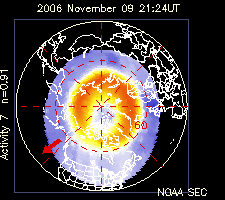IS A NEW SOLAR CYCLE BEGINNING?

Dec. 14, 2007: The solar physics community is abuzz this week. No, there haven't been any great eruptions or solar storms. The source of the excitement is a modest knot of magnetism that popped over the sun's eastern limb on Dec. 11th, pictured below in a pair of images from the orbiting Solar and Heliospheric Observatory (SOHO).
It may not look like much, but "this patch of magnetism could be a sign of the next solar cycle," says solar physicist David Hathaway of the Marshall Space Flight Center.
Above: From SOHO, a UV-wavelength image of the sun and a map showing positive (white) and negative (black) magnetic polarities. The new high-latitude active region is magnetically reversed, marking it as a harbinger of a new solar cycle.
For more than a year, the sun has been experiencing a lull in activity, marking the end of Solar Cycle 23, which peaked with many furious storms in 2000--2003. "Solar minimum is upon us," he says.
The big question now is, when will the next solar cycle begin?
| |
"New solar cycles always begin with a high-latitude, reversed polarity sunspot," explains Hathaway. "Reversed polarity " means a sunspot with opposite magnetic polarity compared to sunspots from the previous solar cycle. "High-latitude" refers to the sun's grid of latitude and longitude. Old cycle spots congregate near the sun's equator. New cycle spots appear higher, around 25 or 30 degrees latitude.
The region that appeared on Dec. 11th fits both these criteria. It is high latitude (24 degrees N) and magnetically reversed. Just one problem: There is no sunspot. So far the region is just a bright knot of magnetic fields. If, however, these fields coalesce into a dark sunspot, scientists are ready to announce that Solar Cycle 24 has officially begun.



<< Home